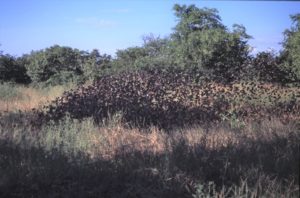Migratory crop pests such as desert locusts, fall armyworms and red-billed queleas are threatening food security across Africa.
Both commercial and subsistence farmers can suffer huge losses, but so far, years of work has not yet managed to curtail the impacts of migratory pests. Unfortunately their combination of high mobility and high abundance due to rapid, opportunistic population growth strategies have proven difficult to combat or find solutions for.
One potential light at the end of this tunnel are early warning systems that can forecast migratory crop pest distribution and abundance. Farmers can act ahead of time as these forecasts can inform their management decisions and resource allocations to enable preventative action. To see the success stories, one need only look at the Desert Locust Information Service (FAO DLIS) and Fall Armyworm Monitoring and Early Warning System (FAWMEWS) developed by the Food and Agriculture Organization of the United Nations.
The development of these early-warning systems requires expert knowledge of a pest species ecology. This is why we must expand our limited understanding of the migratory crop pest bird, the red-billed quelea (Quelea quelea), currently threatening food security across sub-Saharan Africa.
Developing an early-warning system for the red-billed quelea
Working to advance this understanding of red-billed quelea migration patterns and develop an early-warning system is research ongoing at the University of Leeds, funded by the Panorama Natural Environment Research Council (NERC) Doctoral Training Partnership (DTP) and supported by GCRF-AFRICAP.
This granivorous bird is the most abundant in the world. Migrating from country to country and community to community in flocks of up to a million birds. They consume the seed of staple cereal crops, including rice, wheat, sorghum and millet to fuel their breeding in high-density colonies. These nomadic populations follow highly irregular migration patterns as they track dynamic resource availability across the variable landscape.
 Photo: Red-billed quelea flock in sub-Saharan Africa. Credits: Martin Dallimer
Photo: Red-billed quelea flock in sub-Saharan Africa. Credits: Martin Dallimer
At the moment, the only way to control quelea aggregations is by spraying with lethal pesticide fenthion to reduce population size and crop damage, but alarmingly, this is harmful to non-target species too.
The evidence coming in from across sub-Saharan Africa shows only limited success because the sprays take place in response to damage reports, by which time quelea aggregations are too big to manage and crop yield losses have already happened.
Early-warning of quelea influx could improve the efficiency of this lethal control by targeting aggregations promptly. It could also help to promote non-lethal methods, such as altering crop planting schedules or growing varieties that are less vulnerable to quelea, such as those that mature at different times, or do not allow the birds to perch on them to eat seeds.
We are already seeing preliminary results that suggest dynamic crop distribution and short-term weather conditions drive quelea occurrence. By applying these identified relationships, inter- and intra- annual variation in quelea distribution and abundance can be projected accurately at high spatio-temporal resolution across southern Africa – a promising start for an early-warning system for this migratory crop pest bird.
Our preliminary findings could help develop an early-warning system for quelea – a vital tool to protect farmers’ livelihoods and food security across Africa.
About the Author

Rachel Dobson is a postgraduate researcher within the School of Earth and Environment at the University of Leeds. Her work focuses on modelling the migration of nomadic birds in sub-Saharan Africa. For GCRF-AFRICAP, Rachel is developing her forecasting system for the crop pest bird, the red-billed quelea (Quelea quelea). Twitter: @RachelDobson98
This PhD research is supervised by Martin Dallimer, Andrew Challinor and Stewart Jennings (University of Leeds); Robert Cheke (University of Greenwich) and Steve Willis (University of Durham). This research is supported by the Panorama Natural Environment Research Council (NERC) Doctoral Training Partnership (DTP), under grant NE/S007458.1.
